(Speech at the 22nd World Congress of the International Union for Housing Finance, Bangkok, Thailand, reprinted in the HKMA Quarterly Bulletin Issue No.13)
Mr. Chairman, Distinguished Guests, Ladies and Gentlemen,
- I am very honoured to be invited to the 22nd World Congress of the International Union of Housing Finance. The title of my paper today is "Housing Finance and Asian Financial Markets: Cinderella Coming to the Ball". What I really mean is that for too long, residential mortgages and housing finance have been taken for granted and only recently have economists and policy makers realized the central place of housing markets in the efficiency and stability of the whole economy and financial markets. What I intend to do this morning is to put the picture in proper perspective, so that we begin to appreciate this central theme of the proper role of housing finance in the development of Asian financial markets.
- We cannot, of course, discuss Asian financial markets without touching on recent Asian market turbulence. As recently as two years ago, international investors thought that Asia was Miss Universe. Today, they think we are the Ugly Sisters. What the markets are saying is that if we live in a global economy, domestic markets must adjust to global competition. Even real estate markets, previously thought to be dealing in classic illiquid, non-tradable products, have become global in nature. Rich Europeans today have choices in buying property in Malaga, Miami, Cancun or Phuket. As an international investor, you can buy global bonds issued by Fannie Mae, Australian mortgage paper, and even securitised Argentinean MBS. In Hong Kong, the apartment market is so liquid in Taikoo Shing that you can buy an apartment in the morning and sell it in the afternoon. Housing markets are no longer local in nature, subject only to local fashions, but are influenced by global trends. Housing prices are therefore subject to international market discipline. For example, the July issue of the Jones Lang Wootton Property Outlook says that the Bangkok property market has been supported by overseas retailers over the past five years.
- Let me sum up what I intend to address:
- Housing is a main engine of domestic growth, the anchor of social stability, and therefore an important part of macro-economic policy. The financing of housing plays a major role in the stability of the whole financial system.
- Housing also represents, at least in Asia, an important, if not the most important form of household real savings, given the underdeveloped nature of the financial markets. Excessive investment in housing can lead to asset bubbles, the deflation of which can have large implications on output, employment and inflation.
- Despite current problems, East Asia is a young market, experiencing a high rate of urbanisation. The strong demand for housing arising from demographics alone will fairly quickly eliminate excess capacity. We therefore have to build more efficient and robust housing finance systems if we are to intermediate the high rate of domestic savings to more effective investment.
- Housing finance is one of the five major pillars of the financial system, the other pillars being retirement, investment, consumption and payment systems. How should all these pillars be organised so as to support an efficient and robust financial market? Financial markets are like any institutional structure. The structure is only as strong as the foundations. If we manage our housing finance risks better, we can build a stable pillar for the whole financial system.
- To avoid bubbles, we need an integrated and balanced approach to housing finance and financial markets. Rigidities and inefficiencies of housing supply and housing demand need to be taken into consideration. We must use the free market as much as possible to build a balanced financial system and a balanced economy. The new world of global housing markets means that we can build better housing with public sector-private sector partnerships.
- The sound development of primary and secondary mortgage markets are crucial to the development of healthy bond and derivatives markets. As Asian population matures, we will have to build a deep debt market, so that long-term investments in housing are matched by long-term savings. Managing higher risks in a global financial market means that we must manage all our risks better. At that time, Cinderella would have really come to the ball.
Housing as a Pillar of the Economy
- Housing and housing finance, like Cinderella, has too long been taken for granted. Their importance in the macroeconomy can be illustrated by a few key statistics. House ownership is a cornerstone of social stability. On average, between 15 to 40% of household monthly expenditure is spent on housing services. US numbers show at over 60% of household wealth is held in the form of housing and mortgages are the largest component of household debt. The world invests anywhere between 3 to 9% of GDP annually on housing construction, providing jobs for the construction and real estate services sector of between 5 to 10% of the workforce. Due to its low import content, housing construction is regarded as an important domestic engine of growth. Moreover, housing costs carry a large weight in domestic inflation and therefore affects overall competitiveness. The more expensive the housing, the higher domestic wages and the greater pressure on international competitiveness.
- Housing is special because it has economic as well as social implications. Housing market behave just like any other asset markets. Too cheaply priced housing distorts the efficient allocation of scarce resources, as centrally planned economies have found to their costs. Excessively expensive housing contributes to inflation and erodes economic competitiveness in the long run. The efficiency of modern, global economies in the 21st century depends on the efficiency of the urban community. Flexible housing markets help increase the mobility of workers.
- For households, owning one's home is not only an important form of social security, but also the best form of real savings in the long run. Housing protects homeowners from inflation. Between 1970 and 1990, G-7 house prices increased in nominal terms by 8.8% per annum and by 1.5% in real terms. In Asia, because financial markets are fairly segmented, households still cling to housing as the best form of savings. Inflation-adjusted yields of housing are higher than those of financial savings, such as pension, provident funds and bank deposits. In most developed economies, individual home ownership ratios stand high, ranging from 52% in Hong Kong, to 65% in the UK and the US, and to 84% in Singapore (Chart 1). Widespread home ownership offers not only equitable wealth distribution, but is a fundamental objective of any market economy with social equity responsibility.
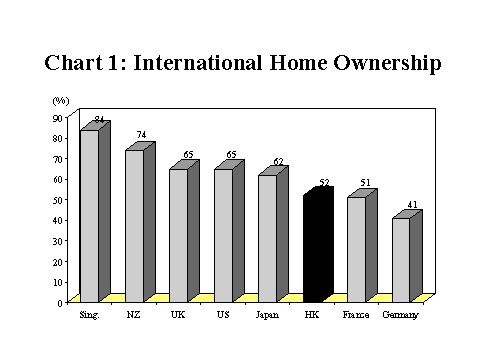
- The demand for housing arising from a growing population and greater urbanisation has put greater pressure on traditional housing finance structures. Traditional building societies, mutual banks and government programmes are no longer sufficient in providing housing finance. Even banks can no longer take the burden. In almost all markets, mortgage-related assets have a high and rising share of total financial assets. In the US, the US$4 trillion residential mortgage market is one of the largest debt markets in the world, bigger than the US Treasuries market. It is also bigger than the total sum of corporate bond market, municipal securities and consumer credit market combined. The origination, servicing and holding of residential mortgages now provides a major income source for the banking systems around the world, with perceived low risks and good returns.
Housing and Housing Finance in East Asia
- Let me now turn to the situation in East Asia. East Asia is a young market. Population growth is still rising at the rate of between 1.2%-2.6% per annum, more than double the population increase of the advanced economies such as Europe and the US (Chart 2). At the same time, East Asia is rapidly urbanising, at perhaps twice to three times the speed of the advanced nations, as our young leave the rural areas. For instance, in Hong Kong and Singapore, almost the entire population live in urban areas. Even for China and Thailand where only one-third of the population is now living in cities, the change has been dramatic given that the shares of urban population were only 17% in Thailand and 19% in China back in 1980 (Chart 3).
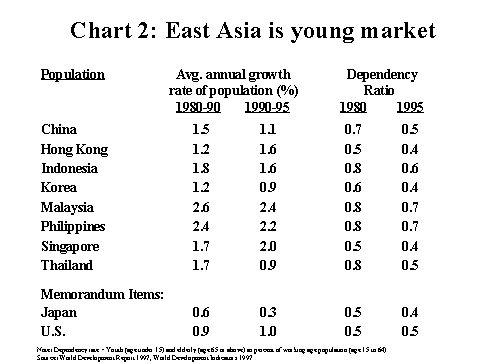
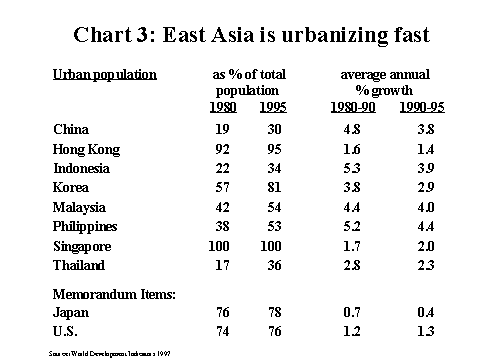
- Add to this potent mixture a rising level of per capita income and you get an explosion in the demand for urban housing. This change in demographics accounts for the massive demand for infrastructure investment, rapid construction in commercial and residential properties and the huge change in city life across Asia. China, for example, invests between 7-9% of GDP on the provision of housing, about the peak level of investment in terms of global trends (Renaud, 1996). Asia has enjoyed a massive boom period in construction, with oversupply in many cities and high prices by any international standards. It would not be an understatement to say that one of the problems facing Asia today is an indigestion of overbuilding in many cities.
- At this rate of urbanisation, a simple question of risk management arises. How can banks, with short-term deposits, continue to finance long-term mortgages in a safe and sound manner?
The Significance of Housing Finance System
- To answer this question, we have to go back to the basic pillars of the financial system. A financial system intermediates between savings and investment. In modern jargon, the financial sector is a derivative of the real economy. From the household point of view, the financial system, as the primary repository of household savings, provides four key services for households. The payments, transactions and liquidity needs of the household are met by the banking system and in the past, postal banking, which together operate the payment system. At the other end of the liquidity spectrum, the retirement and social security services for households are provided by the insurance and provident and pension funds. In the last three decades, mutual funds have grown to meet the investment needs of households, and then building societies, mutual banks and finally banks have met the housing finance needs of households (Chart 4).
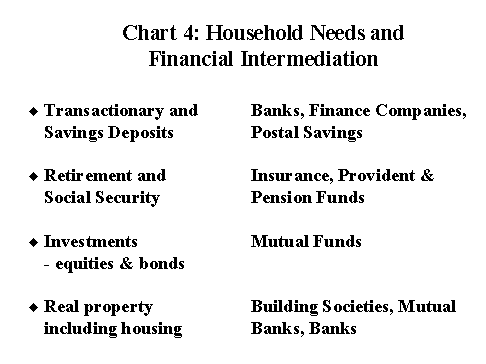
- What we have seen in recent years, as a result of financial innovation and deregulation, is the changing institutional structure of the financial system, as institutions evolve from compartmentalized groups to conglomerates offering the whole range of financial services for households. This "melding" of financial institutions, beginning with the merger of insurance companies and banks and the acquisition of asset management companies by banks, have transformed the financial system. It reflects not only a new way of doing business, a one-stop centre for financial services for households, but also a revolution in asset-liability management. In other words, modern risk management has arrived in the housing finance market.
- I need to point out not only the demographics of household finance, but also the life-cycle of the demand for housing finance to illustrate this. The demographics of household saving is that one consumes before we reach the working age, as our parents or society subsidise our education. When we get married and have children, our rate of savings increase, especially through forced savings such as the repayment of our mortgages. When we retire, we may wish to dissave by drawing down our savings or our equity saved in our houses. A new form of financial service that is rapidly emerging as the world population ages is the reverse mortgage, whereby the retired houseowner lives off the dissavings on his mortgage (Chart 5). More and more innovative financial institutions are beginning to provide this type of financial instrument. In other words, the financial system is helping the households manage their risks better.
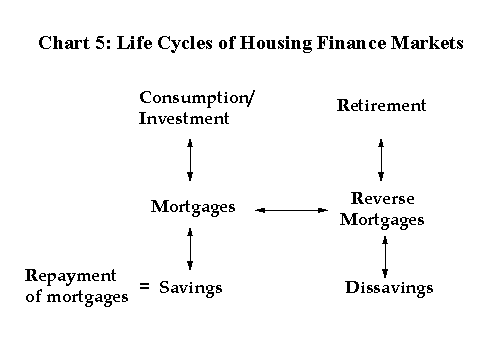
- What risks are we trying to manage? A housing finance system typically manages six types of risks: legal risk, interest rate risk, credit risk, liquidity risk, currency risk and operations risk. If I may be so bold as to offer a grossly simplified explanation of the recent Asian financial turmoil: three risks were primarily the causes:
- First, the liquidity risk - you should not borrow short-term money to finance long-term investments;
- Second, the currency risk - you should not borrow foreign currency funds to finance investments in real estate that do not generate foreign exchange to repay the loans; and
- Third, the credit risk - that collateral for loans is inadequate when assets are incorrectly valued, loan-to-value ratios are too high, and the credit discipline, such as borrower cash flows, was not strictly applied.
- Thus, in order to manage or regulate financial sectors more soundly, greater risk management attention must be paid at both the micro and macro-levels. Risk management errors at the micro level have macro-economic effects. Asset bubbles in housing markets can be caused by a combination of demand and supply side factors. On the demand side, lenders must pay special attention to house affordability. For example, when house prices in the UK declined in the early 1990s after a boom in the late 1980s, many houseowners had negative equity in their houses, because the value of houses was lower than their outstanding mortgages. This constrained the ability of the UK authorities to raise interest rates in the defense of sterling during the ERM crisis of 1992, as higher interest rates would have caused greater mortgage defaults.
- On the other hand, housing supply constraints could also give rise to high housing costs. Examples are inadequate supply of land, excessive tax burden on housing and construction, and inefficient urban planning and approval procedures that delay market responses to the rising demand for housing. For example, the construction of new housing should be coordinated through economically sound urban planning and land development, with proper planning of public infrastructure. Apart from tax reduction, streamlining the administrative approval or registration process can also reduce the housing costs because the shortening of the project development time will lower the interest costs to be incurred during project development.
- When we look at the housing finance system, we begin to appreciate that it is in reality an extremely complex system, involving the transfer of property rights between the builders, sellers, agents, the house-buyers and the lending institutions (Chart 6). In the entire process of housing delivery, it is essential to balance the interests for many parties. Therefore, the rights and obligations of each participant must be clearly defined and protected for the market to work efficiently. For example, households, which are house buyers, want to ensure that the house they are buying are of the right quality and will be delivered on time, and with no physical defects. Lenders such as banks will want to ensure that the finance provided will be recovered from both the housing developer and the ultimate borrower. Support service providers provide legal, surveying and agency services etc.. Bank supervisors will want to ensure that banks are following strict lending criteria, so that banks do not suffer losses to the detriment of the depositors, or the sources of funds. Governments will want to ensure that the property rights are registered and that taxes have been collected. There are also various institutional issues to be noted, such as the need of specialised housing mortgage institutions, mortgage guarantee institutions, computerised property registers and secondary mortgage market.
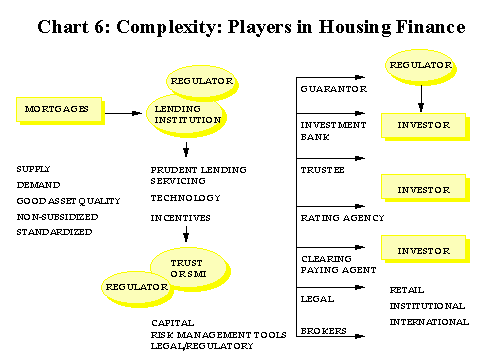
- To repeat, in order to build efficient housing finance systems, we may have to go through different stages of development. The low income economies may have fragmented and illiquid systems, involving subsidised housing programmes. With rising incomes, East Asia has now evolved into fairly deep primary mortgage markets, that are still by and large illiquid in nature. This asset concentration and liquidity risk in the banking system is partly responsible for the inflexibility of the economies to adjust to the rapid globalisation of capital flows.
- For the housing finance market to mature, we need liquid secondary mortgage markets and the associated derivative markets, as in the case of the US. Secondary mortgage markets provide a channel for the banks to offload their mortgages as and when needed. Furthermore, the securitisation of mortgage helps develop the capital market, by matching long-term savings to meet the demand for long-term home financing. Thus we see more and more economies begin to create secondary mortgage markets to manage the asset concentration and liquidity risks. Malaysia established its mortgage corporation, Cagamas, in the early 1980s precisely to deal with this problem. The Hong Kong Mortgage Corporation was established in March 1997 to reduce asset concentration in the banking system in Hong Kong and to stimulate the development of the secondary mortgage market.
- Housing reform in Asia raised five major issues that need to be addressed. First, on the supply side, how can housing costs be reduced? Housing costs in many economies are inflated as a result of inadequate urban planning, a lack of proper coordination of infrastructure and utilities, inefficient construction and project management, as well as the various taxes and charges imposed by different parts of the government. Housing costs may be reduced through the introduction of market competition. For example, Chile reduced public housing costs by 60% when they went for competitive bidding. The reduction of tax burden and the removal of administrative barriers would also help reduce housing costs.
- The second issue relates to the income side and concerns about the measures to raise borrowing affordability. Availability in the housing finance market will be influenced by the willingness of lenders to provide financing for housing as a long-term asset. International experience suggests that access to housing finance is much more important than subsidised finance. If the housing prices are too high, it is extremely inefficient to compensate for this by subsidising interest rates. Such a move would not only distort housing supply, but also worsen efficient allocation of housing finance. On the other hand, housing affordability can in fact be improved by carefully designing the structure of the mortgage, for example, especially by lengthening their loan maturity.
- Third, on the demand side, how can housing finance be improved? A healthy and efficient housing supply market would come along with healthy primary and secondary mortgage markets. A healthy primary mortgage market provides sufficient funds to finance home acquisition, through banks or specialised housing finance institutions. However, the huge demand for housing cannot be met by banks alone. Mismatch in maturity between long-term mortgages and short-term deposits poses a significant liquidity risk to the banking sector. Therefore, there is a need to develop deep secondary mortgage markets, which will facilitate long-term savings to be efficiently allocated to the financing of long-term investments, and thus help manage maturity and currency mismatches. It is important that we have an integrated and balanced approach to housing finance and financial markets.
- The fourth issue is the balance of interests among the various parties involved in the housing market. For example, home buyers would like to ensure that housing is built and completed to agreed standards, while lenders want to be protected against developer default and that mortgages are repaid on time.
- Fifth, how can we avoid real estate overbuilding? As in the case of the developed markets, the oversupply in commercial and residential properties in Asia was a classic case of the fallacy of composition. Buoyed by optimism about future economic growth, the real estate sector, aided by generous credit, thought that the building boom would go on forever and together created an indigestion in supply capacity. Well, many Asian economies are paying for this indigestion in the form of asset deflation. To avoid asset bubbles, we need to re-examine how we can assess and manage the risks not only from the institutional and sectoral point of view, but also from a national risk management perspective.
Housing Finance as Part of the Financial System
- Let me give you an example of how we approached this problem in Hong Kong. Hong Kong has one of deepest primary residential mortgage markets in Asia, with an outstanding residential mortgage to GDP ratio of over 30%. The Informal Working Group on the Secondary Mortgage Market, which I chaired, studied the rising level of housing demand in 1994 and concluded that we needed a secondary mortgage market which would bring the following benefits:-
- Home financing: to help channel long-term savings to meet rising demand for long-term mortgages.
- Banking stability: to provide an avenue for the banks to unload their mortgages, reducing their asset concentration and liquidity risks;
- Monetary stability: a secondary mortgage market would encourage fixed rate loans which would insulate borrowers from interest rate fluctuations, in turn enhancing the resilience of the monetary system to interest rate shocks;
- Debt market development: the secondary mortgage market increases the supply of high-quality debt paper to meet the rising demand for such paper by institutional investors, such as pension and insurance funds.
- The creation of a secondary mortgage market requires a number of pre-conditions. First, inadequacies and barriers in the legal framework, particularly in respect of the land and conveyancing laws have to be rectified to allow efficient and smooth transfer of property rights. Second, a high degree of standardisation in loan origination practice and documentation is required. Third, the interest rate on mortgages must be determined by the market. Fourth, an efficient and robust secondary market infrastructure need to be provided. These conditions were met in the case of Hong Kong.
- The Hong Kong Mortgage Corporation (HKMC) was incorporated early this year and officially commenced business this month. It has come none too soon, because of the anticipated increase in housing supply to meet growing demand. The Hong Kong government has announced a policy objective of raising home ownership from the present level of 50% to 70% by the turn of the century, with an increase in housing supply from current level of 50,000-60,000 units per annum to 85,000 units per annum in about two-three years' time. At about the same time, the emergence of the Mandatory Provident Fund scheme, which would add contracted savings of about 4% of GDP annually to the financial markets, would help absorb the long-term mortgage paper issued by the HKMC. In other words, the long-term savings of Hong Kong people would help finance their housing mortgages.
- We are confident that the HKMC will be highly successful and be a catalyst of both the secondary mortgage market as well as the associated derivative markets that have evolved in parallel in the US and other developed markets.
Conclusion
- Finally, let me put the whole picture back in broader perspective. One of the greatest "gaps" in the Asian financial system is the relative underdevelopment of the bond markets. Asia has deep banking and equity markets, but relatively illiquid debt markets by the standards of the OECD countries (Chart 7). One of the main reasons for this is the absence of fiscal deficits, since Asian governments have by and large been fairly conservative in terms of debt financing. Asia is not short of domestic savings, with national savings ratios of over 30% of GDP. However, if the debt market is not well developed, too much funding is being channeled to asset markets such as stock markets and real estate markets. On the other hand, the deep banking systems are running the risks of financing long-term assets by running a maturity mismatch.
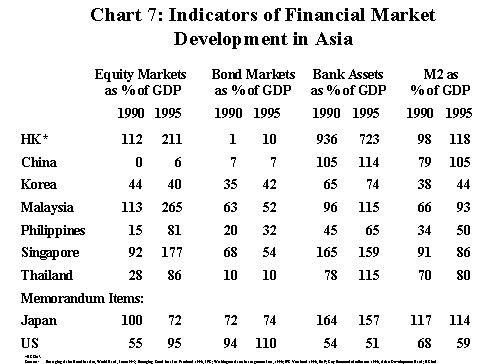
- As the Asian population begins to age, the need for retirement and social security funds will generate the need for a deep, liquid debt market. Such a debt market requires a sound legal framework and good financial infrastructure, such as efficient payment and debt clearing and settlement systems. If Asia is to avoid the maturity and currency mismatches that it is currently facing, the development of debt markets must be a priority. I hope I have demonstrated that an efficient primary and secondary mortgage market is an important component of the debt market. Indeed, it may be useful to point out that emerging Asian markets no longer need to build secondary mortgage markets in sequence after the development of primary markets. The financial technology is now available to build both at the same time.
- What I really want to emphasize is that the experience of recent months have demonstrated that we need balanced economies and balanced financial systems. In the real economy, we cannot forever create growth through an ever-expanding property market, nor can we rely completely on internal adjustments through ever rising exports via exchange rate depreciation. The efficient economy of the 21st century is a flexible, balanced economy, whereby we create growth through productivity increases in both the tradable and non-tradable sectors. Similarly, in the financial system, we need to strike a balance between the development of equity, banking, bond and derivative markets. The financial system is one of the channels whereby we can manage the overall risks in the economy. If managed well, with sound fundamentals, good fiscal discipline, monetary and price stability and robust financial infrastructure, the economy will maintain stable growth and flexibility to cope with the greater volatilities of the global economy.
- In this global financial system, all markets, real or financial, are interrelated. To repeat, the financial system is a derivative of the real economy. As derivative experts all know, the stability of the derivative depends on the stability of the underlying asset, namely, the real economy. Any policy mistake in one market can have contagion effects on the other markets. We should therefore pay greater attention to the rigidities and inefficiencies of the real economy, as much as we pay attention to the imbalances in the financial sector.
- Let me conclude on an optimistic note. I am very confident that Asia, as a young and resilient region, with high savings, will very quickly learn from the mistakes of the recent past and build more wisely for the future. If that is the case, we will not need fairy tales, such as Cinderella, for a happy ending.
- Thank you for your patience.
References
Cutler, Joanne, "The housing market and the economy", Bank of England Quarterly Bulletin, August 1995
Hong Kong Monetary Authority, "Mortgage Corporation Proposal", April 1996
Hong Kong Monetary Authority, "Summary Report on International Seminar of Chinese Housing Finance Policy, organized by People's Bank of China", December 1996
Jaffee, Dwight M. and Renaud, Bertrand, "Strategies to Develop Mortgage Markets in Transition Economies", October 1996
Lamoreaux, Pamela, Presentation on "Establishing Secondary Mortgage Markets in Developing Countries: a Step-by Step approach", July 1997
Pollock, Alex J, "Simplicity versus Complexity in the Evolution of Housing Finance Systems", Housing Finance International, March 1994
Renaud, Bertrand, "The Housing Sector in the National Economy and Its Financing: the International Experience and its Relevance to China", August 1988








